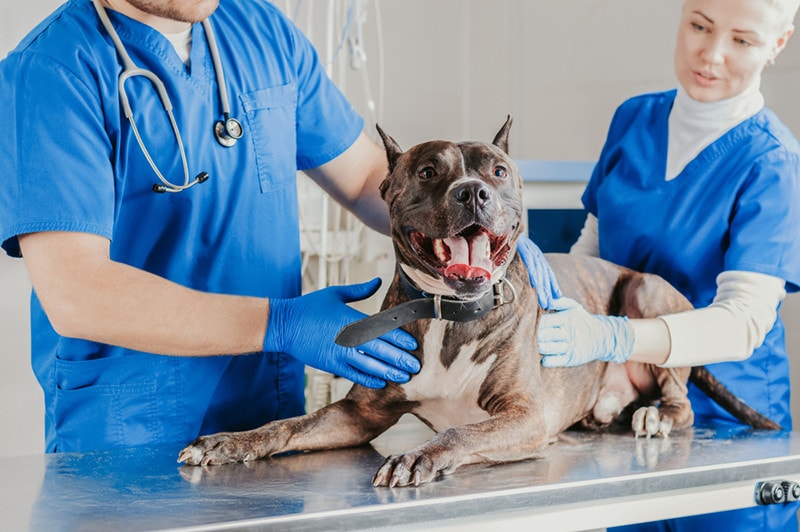Cesarean Sections in Dogs (Vet Answer): Facts, Photos & FAQ
Updated on
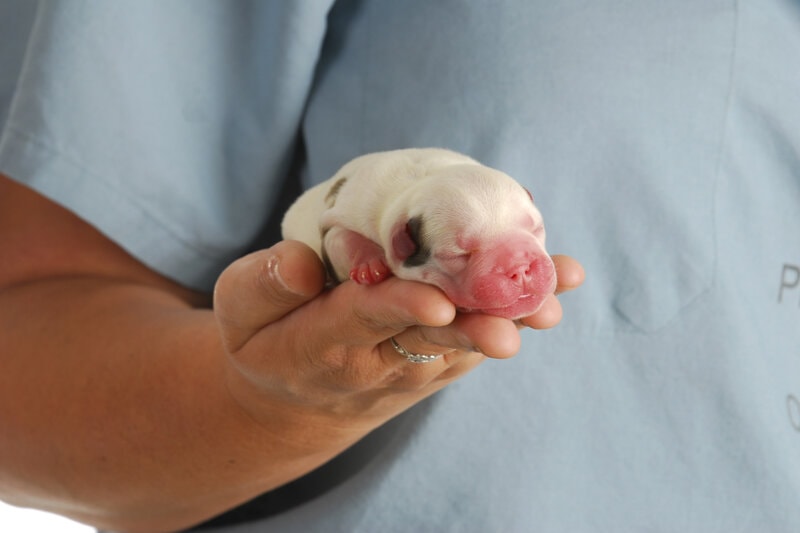
Please note that there are photos in this article that show the process of the safe medical procedure but may be considered disturbing to some.
Bringing a litter of puppies into the world is exciting, but it can also be stressful, especially if complications arise. Just like humans, every birth is unique, and a cesarean section may be required for the safety of the mother and her babies.
This article provides a comprehensive overview of what you can expect if your dog needs a cesarean section and will answer your most frequently asked questions…
What is a dog C-section?
A cesarean section, also known as a C-section, hysterotomy, or cesarean, is a surgical procedure to remove puppies from the uterus (womb) of the dam (mother). In most cases, cesarean sections are performed as an emergency procedure if there is a problem with natural delivery.
They may also be performed as an elective procedure under appropriate circumstances, especially for breeds or individuals who are at increased risk for birthing difficulties.

When Might a Cesarean Section Be Required?
There are many situations in which a cesarean may be the best course of action for the dam and her pups. Though the following situations are some of the most common, it’s important to remember that every birth is unique, and your veterinarian will use their professional judgment to guide the process.
Dystocia
Dystocia or “difficult birth” is the term for when a puppy is unable to be expelled successfully from the mother’s birth canal.
- Illness in the dam (including fever, vomiting, lethargy, or tremors)
- If the dam has been pregnant for more than 70 days after the last mating date
- No signs of whelping (giving birth) more than 24 to 36 hours after the dam’s body temperature has dropped below 100°F
- More than 2-4 hours of intermittent straining before delivery of the first puppy,
- Strong contractions for more than 30 minutes without delivery of a puppy
- Second-stage labor (when the puppies are being delivered) lasts more than 12 hours in total
- More than 1 hour of active labor between puppies
- Constant straining without the birth of a puppy
- Green/black discharge present for 2 hours without the delivery of a puppy
- Labor appears to have stopped for more than 4 hours when you know or suspect there are more pups inside
- Abnormal discharge from the vagina, including excessive bleeding or foul-smelling material
- Seeing a pup stuck within the entrance to the vulva that the dam is unable to deliver
- The dam is experiencing severe pain
If your dog is showing any of these signs or you have any concerns during labor, make sure to call your veterinarian immediately. Delays can result in the death of puppies and the dam.
Common causes of dystocia
Breed
Studies have suggested that anywhere from 3.7–16% of dogs may experience dystocia, and some breeds are more likely to experience difficulty than others. Breeds that have been associated with an increased risk of dystocia include:
- Boston terriers
- French bulldogs
- English bulldogs
- Pugs
- Chihuahuas
- Pomeranians
- Scottish terriers
- Dachshunds
- Pekingese
Of these breeds listed, the prevalence is highest for brachycephalic (flat-faced) breeds, with French bulldogs over 15 times more likely to experience dystocia than average.
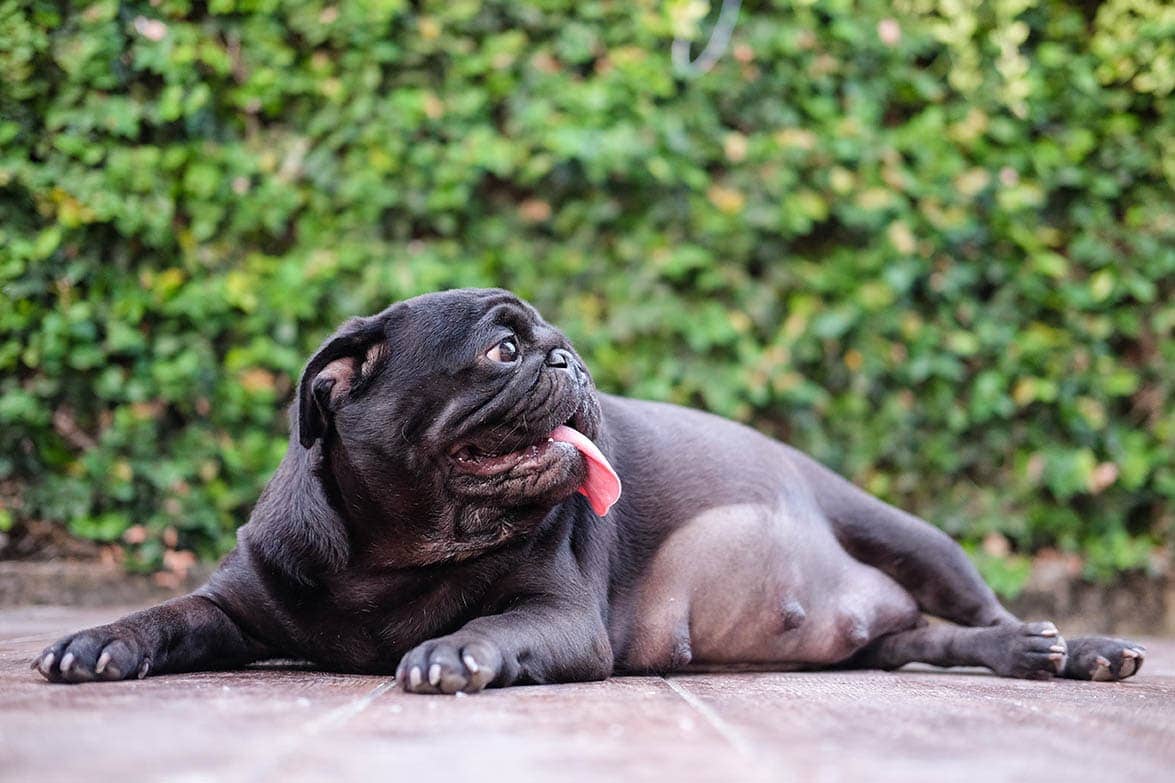
Uterine Inertia
This means the muscles of the mother’s uterus are unable to perform effective contractions to push one or more of the puppies out through the birth canal. Uterine inertia can be further classified into primary and secondary inertia.
Primary inertia is most common, where there is no obvious obstruction (blockage), but no puppies are delivered. Primary uterine inertia has been associated with small litters (three pups or less), as well as very large litters that may result in overstretching of the uterine muscles.
Secondary inertia occurs when there is an obstruction or blockage to the birth canal, and the muscles of the uterus become exhausted trying to push the puppy out.
In some cases of primary uterine inertia, oxytocin may be given by your veterinarian to help stimulate contractions if it is appropriate to do so. However, if this is unsuccessful or there is an underlying obstruction (secondary uterine inertia) or medical indication (such as fetal distress), a cesarean will be required.
Other Maternal Causes
Alongside uterine inertia, other factors affecting the mother can also cause dystocia. These include narrowing of the birth canal due to previous trauma (such as a fractured pelvis) or narrowing of the vagina or vulva.
Though rare, the uterus may also twist (uterine torsion), rupture, or prolapse during labor. Another reason your veterinarian may consider a cesarean section is if the dam is bleeding excessively or showing signs of underlying illness.
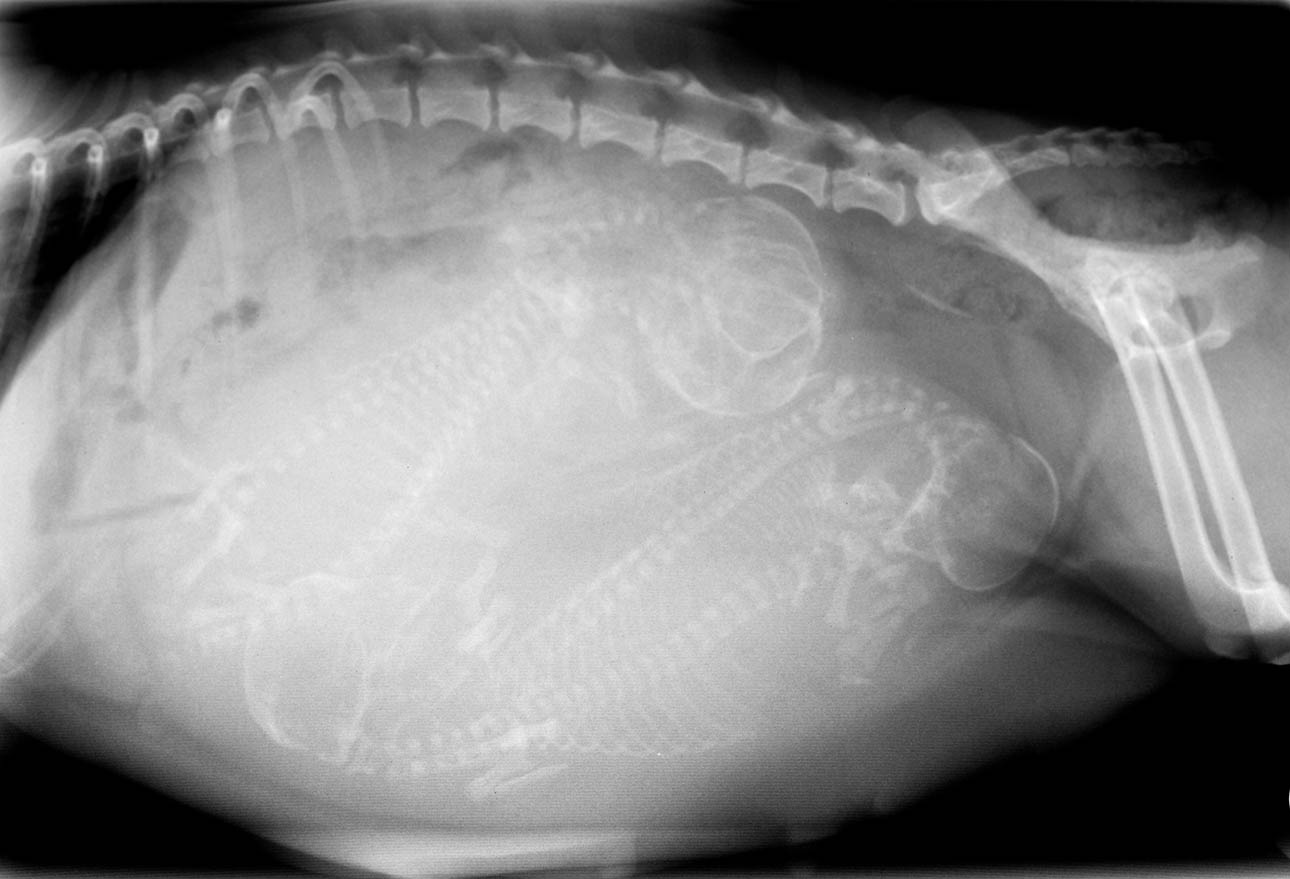
Puppy Causes
Factors that affect the puppies, such as being too large or presenting in an abnormal position, are also common causes of dystocia. Both headfirst and breech (back feet first) are considered normal birthing positions for dogs. Approximately 40% of puppies are born in the breech position. Puppies that enter the birth canal sideways or with their neck twisted are some of the abnormal positions that are likely to lead to dystocia.
Overly large puppies, especially breeds with larger skulls, such as bulldogs, may also be unable to pass through the birth canal. An accidental mating between a smaller-breed female and a larger-breed male can also result in puppies that are too large to be delivered naturally (vaginally).
Puppies born with deformities or abnormalities can become stuck or have difficulty entering the birth canal. In some cases, your veterinarian may be able to remove a puppy lodged within the birth canal carefully, but if not, a cesarean will be required.
Another reason your veterinarian may recommend a cesarean section is if there is evidence of fetal distress (distress to the unborn puppies). Fetal distress is diagnosed by checking their heart rates using an ultrasound. If the heart rate is too low, less than 180 beats per minute, this indicates fetal distress, and a cesarean is recommended.
Sadly, not all puppies will make it to full-term, and the death of a puppy inside the uterus is another reason why a cesarean may be required.
Elective Cesareans
In certain situations, a cesarean section may be planned in advance. This includes females who have previously had difficulty giving birth, high-risk breeds for dystocia, and other circumstances where dystocia is anticipated.
It’s vital that an elective cesarean occurs as close as possible to the natural whelping (birthing) date. This ensures the puppies are fully developed and have the best chance of survival when delivered.
Your veterinarian will often perform multiple diagnostic tests to confirm the timing of a cesarean is correct. These include blood tests for progesterone hormone levels (which drop within 24 hours of first-stage labor) and ultrasound examination. The dam’s core body temperature will also drop below 100°F within 24 hours of first-stage labor, which pet parents should be encouraged to monitor at home.
What Will Happen at the Vet Clinic During a Cesarean Section?
Your veterinarian will examine your dog closely and, in most cases, perform diagnostic tests, including blood tests, x-rays, and an ultrasound examination, before deciding to perform a cesarean section.
Once they have discussed their findings with you, you will sign a consent form for the procedure to proceed. In an emergency, verbal consent may also be given over the phone. The team will then set up the operating room and all recovery equipment needed for the mother and her pups.
Surgical preparation and anesthesia
The veterinary team will then prepare your dog for surgery by placing them on a drip to help support their blood pressure during anesthesia. They will also clip and clean the surgical site (underside of the belly) before placing her under a general anesthetic.
This is to minimize the amount of time the dam and puppies spend under anesthesia; most cesarean sections take 45 minutes to an hour to complete. Most veterinarians will not give any premedication (sedation) before a cesarean due to the risk to the puppies and will simply give an injection into the veins to induce anesthesia in the operating room.
Once anesthetized, a tube will be placed into the windpipe (trachea) so that oxygen and anesthetic gas can be given for the duration of the surgery.
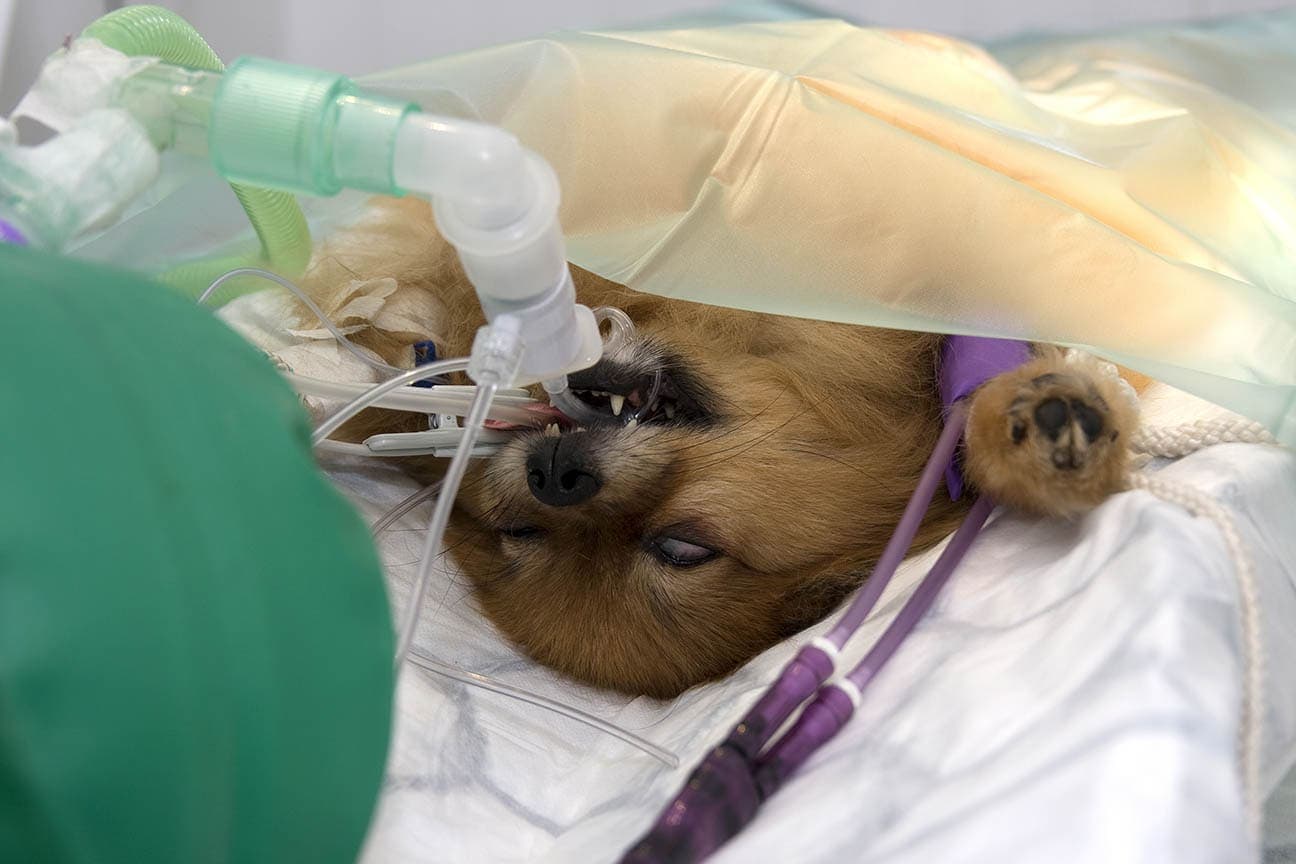
Surgical Technique
The veterinary surgeon will cut down the middle of the belly to provide access to the uterus and safely remove the pups. Once the surgeon has access to the uterus, they make a cut in the uterus (called a hysterotomy).
The surgeon will remove a puppy, take off the amniotic sac surrounding them, and clamp the umbilical cord before handing them to a veterinary technician or nurse for resuscitation.
Once all the puppies have been removed safely, the surgeon will close the incision they’ve made in the uterus with fine dissolvable suture material. They will then suture the abdominal incision closed in three layers (the muscle layer, the fat layer, and the skin layer). This provides a good, strong closure.
Some surgeons will give oxytocin if the uterus isn’t contracting normally and assist with milk production. While the surgeon is taking care of the mother, other members of the team will be responsible for the resuscitation of the puppies. This involves clearing their noses and mouths of mucus and fluid and vigorous rubbing to stimulate breathing and oxygenation.
Can You Spay Dogs During C-sections?
In certain situations, pet parents will give consent for a cesarean combined with a spay (ovariohysterectomy) to remove the female’s reproductive tract and prevent future pregnancies.
A spay during a c-section might be for dams that have suffered from dystocia whose parents would prefer to avoid another surgery at a later date, or dams with abnormalities to the uterus, such as prolapse or torsion that means the uterus is damaged beyond repair.
Performing a spay at the same time as a cesarean does not affect milk production for the dam.
What Are the Risks and Complications of a C-Section for Dogs?
Though a cesarean section is often highly successful and can be life-saving for mothers and their pups, it’s important to remember it’s still a major surgery with the potential for complications.
The cesarean is associated with a 99% survival rate for the dam. Possible surgical complications may include bleeding, reaction to the anesthetic, infection, and swelling or breakdown of the surgical site.
For pups, the survival rate can be a little more variable, depending on the circumstances, and is estimated at around 87%. However, it’s important to remember that natural delivery has also been shown to carry similar risks for puppies. Some puppies can also experience injuries during delivery with the use of forceps or other interventions.
How much is a dog C-section?
It’s important to remember that even though most dogs recover quickly, there are risks for the mother and her unborn puppies. It can also be expensive, especially if surgery needs to be performed out of hours in an emergency hospital. New or first-time breeders should be well aware of the potential risks and costs associated with an emergency cesarean section before going ahead with a planned mating.
A cesarean section will cost anywhere from $500 at a local clinic to $2,000 at an out-of-hours emergency hospital. The cost will vary depending on individual circumstances and can be much higher for more complex cases requiring additional care.
When planning a litter, a visit with your veterinarian is essential to assess your dog’s health, breeding soundness, behavior, and what to expect during the pregnancy. 3.3 million dogs are surrendered to animal shelters every year in the US, so it’s important that pet parents understand the importance of responsible breeding.
How Should I Prepare for a Cesarean Section?
As many cesarean sections are performed as an emergency, it’s best to be prepared in case your dog needs one. At home, make sure to set up a warm, quiet area for the dam and her nursing pups. Equipment for feeding newborn puppies, such as syringes, nursing bottles, puppy formula, and scales, are also vital. A comprehensive list of essential items can be found here.
Your veterinarian will advise you of their clinic’s protocol for elective cesareans in preparation for surgery. No food should be given to the dam on the morning of the cesarean, but feeding dinner the night before is fine.
When traveling to the clinic, make sure you have a charged cell phone, waterproof covers for the inside of your car, a bulb syringe and mucus trap, blankets and towels, a plastic laundry tub or similar to take the pups home, a heating pad, and of course the expectant mother!
For emergency caesareans, you may not get much time to prepare. It’s best to plan for the worst-case scenario, however, and have as much as possible on hand, as well as phone numbers and directions to the nearest vets that may be able to do the procedure.
What Should I Expect During the Recovery Period?
Recovery from anesthesia will take a couple of hours, and your veterinarian will advise you when it’s safe to take the dam and her puppies home. She will have received pain relief and will be sent home with additional medication for you to administer at home.
Your veterinarian has chosen the medications carefully to minimize risk to the dam and her nursing puppies. Follow the instructions carefully and do not administer any medications unless strictly advised to do so by your veterinarian. This includes home remedies, creams, and ointments of any kind.
Encourage Eating and Drinking
Encourage the new mother to eat and drink within a few hours, starting with small amounts to reduce the chance of her vomiting. Feeding the dam a high-quality puppy food will help meet the increased nutritional demands for nursing puppies.
When introducing the pups to the dam, it is vital to supervise closely, especially during the early days of feeding. The mother can reject or even behave aggressively toward her new pups.
Until you’re confident that the dam is showing signs of normal mothering behavior, it’s better for the pups to feed when she’s calm and settled at home under full supervision. The pups may need you to guide them toward the nipples, and you can also try gently expressing milk to encourage them to suckle.
Once they have finished feeding, make sure the mother licks their rear ends (perineum) to stimulate normal toileting (urination and defecation). If she doesn’t, you must do it with a damp cloth or cotton ball.
If necessary, you may need to repeat this supervised feeding process every 2 hours until you feel comfortable leaving the puppies with the dam. Between feeds, the pups should be kept in a warm basket or container with a fabric covering over the top.
Puppies should be monitored closely to ensure they feed properly and gain weight. Your veterinarian can provide more detailed advice on caring for newborn puppies, including bottle feeding if required.
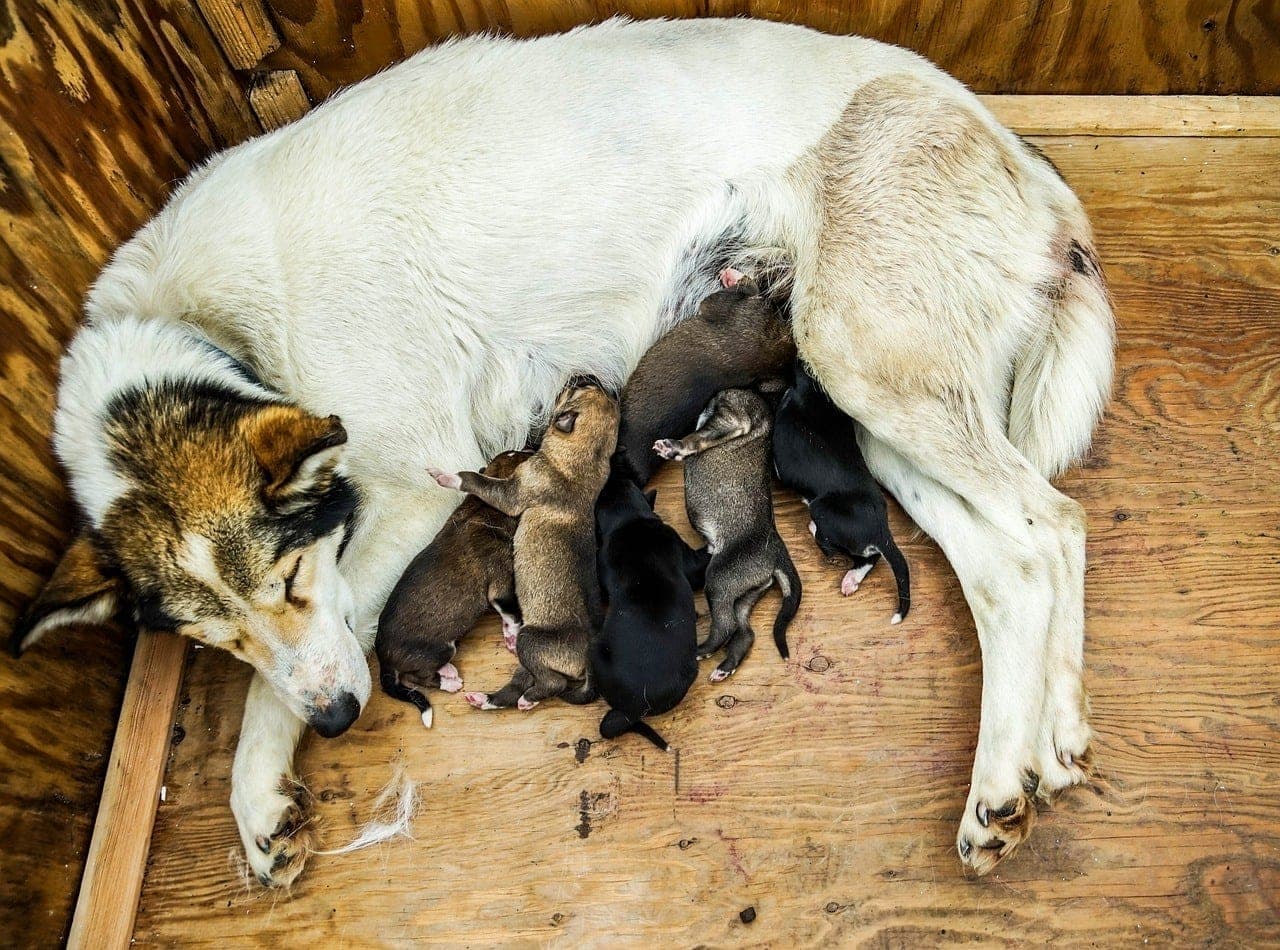
Rest
A new mother who has undergone a cesarean section will also need to rest carefully for the next 7 to 10 days. The only exercise should be walking on a leash to the toilet. Your veterinarian may recommend gently cleaning the surgical site, but follow their instructions closely.
Your veterinarian will remove the skin sutures (stitches) 7–10 days after the surgery. Sometimes, a surgeon may choose to use dissolvable skin sutures that don’t require removal. You may notice a bloody vaginal discharge for up to 7 days after the dam has given birth, but if there is an excessive amount of blood, the dam seems unwell, or this discharge persists, contact your veterinarian immediately.
Dog C-Sections: Conclusion
Though this article has been written as a comprehensive guide to cesarean sections in dogs, it cannot possibly cover every individual scenario and does not replace the advice of your veterinary surgeon. From thinking about breeding your dog to caring for young puppies, they are there to guide you through every step of the process as safely as possible.
- You might also be interested in: Ask A Vet: Lip Fold Pyoderma in Dogs – Causes and Treatments
Featured Image Credit:WilleeCole Photography, Shutterstock








